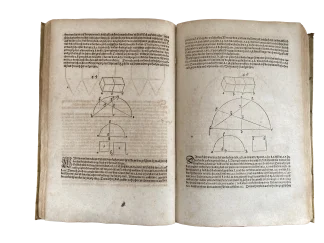DÜRER, Albrecht.
FROM THE HERMANN GÖRING SCHOOL FOR ARTISTS
Opera Alberti Dureri. Das ist, Alle Bücher des weitberühmbten und Künstreichen Mathematici und Mahlers Albrechten Durers von Nürenberg.
Arnhem, Johan Jansen, 1603-4.£10,750.00
FIRST COMPLETE EDITION IN GERMAN. Folio. 3 parts in 1, first with part title, I: ff. [ii], [89] [1, blank]; II: ff. [131], [1 blank]; III: ff. [26]. Gothic letter. General title and part title with large woodcut Dürer monogram, c.400 full-page or smaller woodcuts of geometrical or human figures, building plans and typographical letters (2 with overslip, couple in early colouring), 15 double-page plates (14 folding), woodcut initials (some hand-coloured) and ornaments. Some browning. A good copy in early ¼ calf over contemporary vellum, yapp edges, remains of ties, modern morocco label, traces of coloured arms of the Waldburg-Wolfegg to upper cover, their C19 stamp to title (both sides) and last, early ms initials, C17 engraved armorial Waldburg-Wolfegg bookplate, label of W.A. Foyle, Beeleigh Abbey, and C20 label ‘BT’ to front pastedown, stamp of the Herman Göring School for Artists in Kronenburg (acquisition 1938) to title verso.
Good copy in contemporary binding of the first complete edition of Albrecht Dürer’s collected works in German – handsomely illustrated with c.400 woodcuts produced using Dürer’s original blocks from the 1525-28 eds. ‘In the illustration of principles [of Renaissance art] lies the great historical importance of Dürer’s theoretical writings […]. They were the foundation of accepted aesthetic dogma until the C19’ (PMM 53, 1525 ed. of ‘Underweysung der Messung’). Dürer (1471-1528) was a German painter, printmaker and draughtsman. After travelling in Germany and Italy, he returned to his native Nuremberg, and had Maximilian I as his patron from 1512. His fame spread throughout Europe thanks to his book illustrations, prints and cartographic works. He also wrote several theoretical works in German. ‘Dürer, like Luther, had to create a German language of his own. Like Luther, he took a more or less standardized chancery style as a basis and infused life into it, not by a futile attempt at humanistic oratory but, on the contrary, by listening to the man in the street […]. In the end [he] not only managed to describe complicated geometrical constructions more briefly, more clearly and more exhaustively than any professional mathematician of his time, but also expressed historical facts and philosophical ideas in a prose style no less “classic” than Luther’s translation of the Bible’ (Panofsky, p.245).
At the core of Dürer’s theoretical works lies the Renaissance art principle that the representation of an object should be faithful and proportionate to its appearance in reality. The first work – ‘Underweysung der Messung’ (first ed., 1525) – is a treatise on measurement, and perspective using the compass and ruler. ‘It is the first literary document in which a strictly representational problem received a strictly scientific treatment at the hands of a Northerner’ (Panofsky, p.253). It is a manual for draughtsmen on the drawing of linear geometry and polygons, with famous sections on the geometric rendition of the Latin, after the Italian model (and anticipating G. Tory), and Gothic alphabets, the latter following a new modular system whereby letters are divided into small equal squares. ‘If of anything, this cumulative method is reminiscent of Arabic, and not of Italian, calligraphy’ (Panofsky, p.258). Another section is devoted to architecture, and woodcut n.34 shows gores and sections of globe maps. A couple of final woodcuts illustrate how to calculate where the shade of an object will be in relation to the sun, as well as two scenes of artists at work using a lens attached to the easel and a weighed lead wire to render the perspective.
The second – ‘Vier Bücher von Menschlicher Proportion’ (first ed., 1528) – is entirely devoted to the drawing of human figures according to their natural proportions. The charming woodcuts provide specific measurements for full-page human figures – male, female, older, younger, thinner, larger – from the front, side and back, and in various positions, with a woodcut specifically devoted to the proportions between the fingers and several woodcuts of the head (even as seen from above). Dürer also offers observations on ideal beauty and aesthetics, just after the third part, and ‘it is in this “aesthetic excursus,” as it is commonly referred to, that we find the final statement of what may be called Durer’s philosophy of art’ (Panofsky, p.273). The third and last treatise is devoted to the building of castles and fortifications (first ed., 1527), with numerous double-page, folding woodcut plates of plans and elevations. ‘Strictly speaking the first treatise dealing exclusively with this subject’ (Kruft, p.110). In addition to providing advice on strengthening existing fortifications, Dürer also ‘outlines a utopian city’, seen as a ‘fortified citadel’, built – as in a ‘job-creation scheme’ – by unemployed poor people, so as to stop them begging, as had happened with the Egyptian pyramids (Kruft, p.110-11).
This fascinating copy was in the library of the Counts of Waldburg, possibly Maximilian Willibald of Waldburg-Wolfegg (1604–67), military commander and the governor of Upper Palatinate. He was polyglot, a keen owner of medical, scientifical and alchemical books, as well as, from 1650, of books on graphics, thousands of which he acquired from the Fugger family’s collections. From 1938, it was in the library of the Herman Göring School for Artists (Meisterschule für Malerei) in Kronenburg, inaugurated and patronised by Göring as a place to establish the artistic style and pictorial propaganda of the regime, and to train its future exponents. Unsurprisingly, it was closed down in 1945. Its library included a few fine medieval mss. The school’s logo reproduced Göring’s own device.
USTC 2013816; VD17 3:315265B; Bohatta 33c; Spaendonck, Catalogus van de Arnhemse drukken tot 1800, n.7; E. Panofsky, The Life and Art of Albrecht Dürer (1945); H.-W. Kruft, A history of architectural theory (1994).In stock









